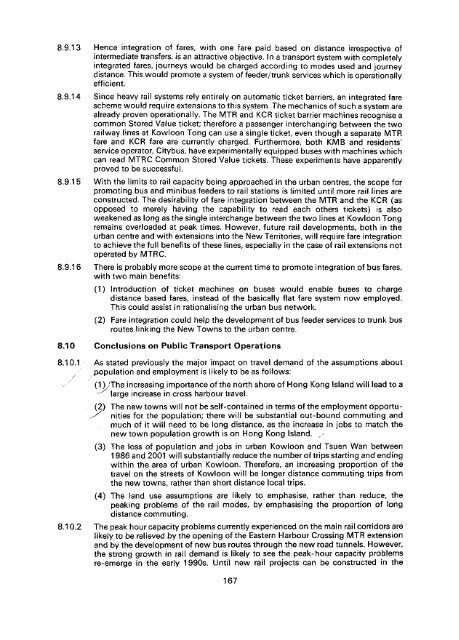Untitled - HKU Libraries - The University of Hong Kong
Untitled - HKU Libraries - The University of Hong Kong
Untitled - HKU Libraries - The University of Hong Kong
- No tags were found...
You also want an ePaper? Increase the reach of your titles
YUMPU automatically turns print PDFs into web optimized ePapers that Google loves.
8.9.13 Hence integration <strong>of</strong> fares, with one fare paid based on distance irrespective <strong>of</strong>intermediate transfers, is an attractive objective. In a transport system with completelyintegrated fares, journeys would be charged according to modes used and journeydistance. This would promote a system <strong>of</strong> feeder/trunk services which is operationallyefficient.8.9.14 Since heavy rail systems rely entirely on automatic ticket barriers, an integrated farescheme would require extensions to this system. <strong>The</strong> mechanics <strong>of</strong> such a system arealready proven operationally. <strong>The</strong> MTR and KCR ticket barrier machines recognise acommon Stored Value ticket; therefore a passenger interchanging between the tworailway lines at Kowloon Tong can use a single ticket even though a separate MTRfare and KCR fare are currently charged. Furthermore, both KMB and residents'service operator, Citybus, have experimentally equipped buses with machines whichcan read MTRC Common Stored Value tickets. <strong>The</strong>se experiments have apparentlyproved to be successful.8.9.15 With the limits to rail capacity being approached in the urban centres, the scope forpromoting bus and minibus feeders to rail stations is limited until more rail lines areconstructed. <strong>The</strong> desirability <strong>of</strong> fare integration between the MTR and the KCR (asopposed to merely having the capability to read each others tickets) is alsoweakened as long as the single interchange between the two lines at Kowloon Tongremains overloaded at peak times. However, future rail developments, both in theurban centre and with extensions into the New Territories, will require fare integrationto achieve the full benefits <strong>of</strong> these lines, especially in the case <strong>of</strong> rail extensions notoperated by MTRC.8.9.16 <strong>The</strong>re is probably more scope at the current time to promote integration.<strong>of</strong> bus fares,with two main benefits:(1) Introduction <strong>of</strong> ticket machines on buses would enable buses to chargedistance based fares, instead <strong>of</strong> the basically flat fare system now employed.This could assist in rationalising the urban bus network.(2) Fare integration could help the development <strong>of</strong> bus feeder services to trunk busroutes linking the New Towns to the urban centre.8.10 Conclusions on Public Transport Operations8.10.1 As stated previously the major impact on travel demand <strong>of</strong> the assumptions aboutpopulation and employment is likely to be as follows:(1),<strong>The</strong> increasing importance <strong>of</strong> the north shore <strong>of</strong> <strong>Hong</strong> <strong>Kong</strong> Island will lead to ax large increase in cross harbour travel.(2) <strong>The</strong> new towns will not be self-contained in terms <strong>of</strong> the employment opportu-/ nities for the population; there will be substantial out-bound commuting andmuch <strong>of</strong> it will need to be long distance, as the increasejn jobs to match thenew town population growth is on <strong>Hong</strong> <strong>Kong</strong> Island, x(3) <strong>The</strong> loss <strong>of</strong> population and jobs in urban Kowloon and Tsuen Wan between1986 and 2001 will substantially reduce the number <strong>of</strong> trips starting and endingwithin the area <strong>of</strong> urban Kowloon. <strong>The</strong>refore, an increasing proportion <strong>of</strong> thetravel on the streets <strong>of</strong> Kowloon will be longer distance commuting trips fromthe new towns, rather than short distance local trips.(4) <strong>The</strong> land use assumptions are likely to emphasise, rather than reduce, thepeaking problems <strong>of</strong> the rail modes, by emphasising the proportion <strong>of</strong> longdistance commuting.8.10.2 <strong>The</strong> peak hour capacity problems currently experienced on the main rail corridors arelikely to be relieved by the opening <strong>of</strong> the Eastern Harbour Crossing MTR extensionand by the development <strong>of</strong> new bus routes through the new road tunnels. However,the strong growth in rail demand is likely to see the peak-hour capacity problemsre-emerge in the early 1990s. Until new rail projects can be constructed in the167
















